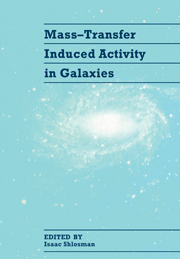Book contents
- Frontmatter
- Contents
- Preface
- List of Participants
- I INTRODUCTION
- II THE INNER PARSEC
- III THE CIRCUMNUCLEAR REGION
- IV GAS DYNAMICS AND STAR FORMATION IN BARRED AND NORMAL GALAXIES
- V NUCLEAR GAS AND LARGE-SCALE PROPERTIES OF AGN AND STARBURST HOSTS
- HI and H2 in Luminous Interacting Galaxies (Invited paper)
- HIFI Results on the Superbubble of NGC 3079
- Low Surface Brightness Galaxies: Evolution without Mass Transfer
- Bulge Formation by Starbursts in Young Galaxies
- CO Observations of Nearby Active Galaxies
- Starburst Evolution on the IRAS–Color Diagram
- Cloud Collisions and Bulge Formation in Disk Galaxies 23
- VI HOST GALAXY-AGN-NUCLEAR STARBURST CONNECTION
- VII GALAXY INTERACTIONS AND INDUCED ACTIVITY
- VIII GAS DYNAMICS IN ELLIPTICALS
- IX AGN AND STARBURST HOSTS AT LARGE REDSHIFTS
- X CONFERENCE SUMMARY
- Subject Index
- Object Index
- Author Index
HI and H2 in Luminous Interacting Galaxies (Invited paper)
Published online by Cambridge University Press: 05 May 2010
- Frontmatter
- Contents
- Preface
- List of Participants
- I INTRODUCTION
- II THE INNER PARSEC
- III THE CIRCUMNUCLEAR REGION
- IV GAS DYNAMICS AND STAR FORMATION IN BARRED AND NORMAL GALAXIES
- V NUCLEAR GAS AND LARGE-SCALE PROPERTIES OF AGN AND STARBURST HOSTS
- HI and H2 in Luminous Interacting Galaxies (Invited paper)
- HIFI Results on the Superbubble of NGC 3079
- Low Surface Brightness Galaxies: Evolution without Mass Transfer
- Bulge Formation by Starbursts in Young Galaxies
- CO Observations of Nearby Active Galaxies
- Starburst Evolution on the IRAS–Color Diagram
- Cloud Collisions and Bulge Formation in Disk Galaxies 23
- VI HOST GALAXY-AGN-NUCLEAR STARBURST CONNECTION
- VII GALAXY INTERACTIONS AND INDUCED ACTIVITY
- VIII GAS DYNAMICS IN ELLIPTICALS
- IX AGN AND STARBURST HOSTS AT LARGE REDSHIFTS
- X CONFERENCE SUMMARY
- Subject Index
- Object Index
- Author Index
Summary
ABSTRACT
The interstellar gas plays a fundamental role in the interacting galaxy systems: it is dissipative and thus responds irreversibly to strong dynamical perturbations; it is also the active component which fuels starbursts and may fuel AGNs in the central regions of the galaxies. In this article we review new high resolution aperture synthesis observations of the atomic and molecular gas in luminous interacting galaxies.
Due to the extended nature of the atomic gas in disk galaxies, the HI observations bear most critically on the long range tidal perburbations and therefore serve to elucidate the interaction history. Here we summarize the HI observations of six systems: the M81/M82 group and five interacting pairs with long tidal tails. In all of these systems the impact of geometry is evident from the spatial and kinematic structure of the atomic gas within the extended tidal features. The six systems may be crudely placed in a temporal sequence for galactic merging — in the early stages large amounts of HI still exist within the galactic disks and the star formation is spread throughout the disks as evidenced by Hα emission while in the final stages the HI is almost entirely contained within the tidal features beyond the merger body and the molecular gas is mostly found in the central remnant.
Molecular line observations have largely concentrated on the intermediate evolutionary phase in which the galaxies become strongly emitting in the far infrared. Molecular line surveys of luminous infrared bright galaxies sampled by the IRAS survey have shown these galaxies to be extraordinarily rich in molecular gas as evidenced by the CO emission.
- Type
- Chapter
- Information
- Mass-Transfer Induced Activity in Galaxies , pp. 191 - 212Publisher: Cambridge University PressPrint publication year: 1994
- 12
- Cited by

